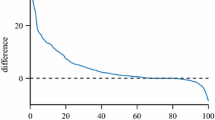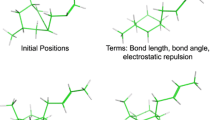Abstract
Strategies are described for constructing pharmacophoric 3D database queries, based on aseries of active and inactive analogs. The results are highly selective database queries, whichare consistent with the generally accepted pharmacophore for a number of systems. Thefoundation of these strategies is the method of Mayer, Naylor, Motoc and Marshall [J.Comput.-Aided Mol. Design, 1 (1987) 3] for inferring a unique binding geometry forangiotensin-converting enzyme (ACE) inhibitors. The strategies described here generalize theirapproach to cases where the chemical features responsible for binding are not a prioriapparent, and to cases where the binding geometry deduced by that method is not unique. Thekey new insight, the selectivity principle, is to rank the multiple solutions produced by themethod of Mayer et al. by their selectivity, a value that is related to the proportion of adatabase that is returned as a database hit list. Retrospective analyses are described for D2-antagonists, ACE inhibitors, fibrinogen antagonists, and β2-antagonists.
Similar content being viewed by others
References
Kuntz, I.D., Blaney, J.M., Oatley, S.J., Langridge, R. and Ferrin, T.E., J. Mol. Biol., 161 (1982) 269. b. DesJarlais, R.L., Sheridan, R.P., Dixon, J.S., Kuntz, I.D. and Venkataraghavan, R., J. Med. Chem., 29 (1986) 2149.
Gund, P., Annu. Rep. Med. Chem., 14 (1979) 299.
Brint, A.T. and Willett, P., J. Mol. Graph., 5 (1987) 49.
VanDrie, J.H., Weininger, D. and Martin, Y.C., J. Comput.-Aided Mol. Design, 3 (1989) 255.
Sheridan, R.P., Nilakantan, R., Rusinko, A., Bauman, N., Haraki, K.S. and Venkataraghavan, R., J. Chem. Inf. Comput. Sci., 29 (1989) 255.
Christie, B.D., Henry, D.R., Güner, O.F. and Moock, T.E., Online Inf., 90 (1990) 137. b. Moock, T.E., Henry, D.R., Ozkabak, A.G. and Alamgir, M., J. Chem. Inf. Comput. Sci., 34 (1994) 184.
Murrall, N.W. and Davies, E.K., J. Chem. Inf. Comput. Sci., 30 (1990) 312.
Van Drie, J.H., Berezin, S. and Ku, S.-L., Abstracts for the ACS National Meeting, Spring, 1992, CINF 023. No detailed description of the Catalyst 3D database searching software has been published.
Hurst, T., J. Chem. Inf. Comput. Sci., 34 (1994) 190. No further details have been published on the Unity 3D database searching software.
Marshall, G.R. and Cramer, R.D., Trends Pharmacol. Sci., 9 (1988) 285.
Good, A.C. and Mason, J.S., In Lipkowitz, K.B. and Boyd, D.B. (Eds.) Reviews in Computational Chemistry, Vol. 7, VCH, New York, NY, U.S.A., 1996, pp. 67–117.
Mayer, D., Naylor, C.B., Motoc, I. and Marshall, G.R., J. Comput.-Aided Mol. Design, 1 (1987) 3.
Ondetti, M.A., Cushman, D.W. and Rubin, B., In Bindra, J.S. and Lednicer, D. (Eds.) Chronicles of Drug Discovery, Vol. 2, Wiley, New York, NY, U.S.A., 1983, pp. 1–31.
Seeman, P., Watanabe, M., Grigoriadis, D., Tedesco, J.L., George, S.R., Svensson, U., Nilsson, J.L. and Neumeyer, J.L., Mol. Pharmacol., 28 (1985) 391.
Bartlett, P.A., Shea, G.T., Telfer, S.J. and Waterman, S., In Roberts, S.M. (Ed.) Molecular Recognition: Chemical and Biological Problems, Vol. 78, Royal Society of Chemistry, London, U.K., 1989, pp. 182–192. b. Lauri, G. and Bartlett, P.A., J. Comput.-Aided Mol. Design, 8 (1994) 51.
Van Drie, J.H. and Martin, Y.C., Workshop on 3D databases at the Crystallography and Drug Design Conference, Erice, Italy, June dy1989.
Karlin, S. and Brendel, V., Science, 257 (1992) 39.
Van Drie, J.H., J. Comput.-Aided Mol. Design, 10 (1996) 623.
Lloyd, E.J. and Andrews, P.J., J. Med. Chem., 29 (1986) 453. Note that, while we identify the basic amine as a ‘positive-charge’ group, they identify it as an H-bond donor. It is difficult to say precisely what the protonation state of that nitrogen is when bound to the receptor.
Strader, C.D., Sigal, I.S. and Dixon, R.A.F., FASEB J., 3 (1989) 1825.
Hansch, C., Sammes, P.G. and Taylor, P.G. (Eds.) Comprehensive Medicinal Chemistry, Pergamon, Oxford, U.K., 1990.
Samanen, J., Ali, F., Romoff, T., Calvo, R., Sorenson, E., Vasko, J., Storer, B., Berry, D., Bennett, D., Strohsacker, M., Powers, D., Stadel, J. and Nichols, A., J. Med. Chem., 34 (1991) 3114.
Hartman, G.D., Egbertson, M.S., Halczenko, W., Laswell, W.L., Duggan, M.E., Smith, R.L., Naylor, A.M., Manno, P.D., Lynch, R.J., Zhang, G., Chang, C.T.-C. and Gould, R.J., J. Med. Chem., 35 (1992) 4640.
The Catalyst software is available from Molecular Simulations Inc., San Diego, CA, U.S.A. Conformers were generated using the so-called ‘fast’ methodology (torsion-angle driving with energy-minimization post-processing) with an 8.0 kcal/mol cutoff. Up to 150 conformers/molecule were generated. The flexible database searching used does not perform any on-the-fly manipulation of the conformers, but rather relies strictly on the conformers stored in the database. There is some difference between the way in which Catalyst defines features and the way in which the custom software implementing the procedure of Mayer et al. defines them, especially for the ‘hydrophobic’ feature. However, in principle, one should be able to reproduce this analysis with any method of conformational analysis which effectively explores all energetically reasonable regions of conformational space, and any database search system which allows one both to express the concepts we discuss here, and which takes into account conformational flexibility in analyzing a molecule for possible hits.
Author information
Authors and Affiliations
Rights and permissions
About this article
Cite this article
Drie, J.H.V. Strategies for the determination of pharmacophoric 3D database queries. J Comput Aided Mol Des 11, 39–52 (1997). https://doi.org/10.1023/A:1008019326401
Issue Date:
DOI: https://doi.org/10.1023/A:1008019326401




